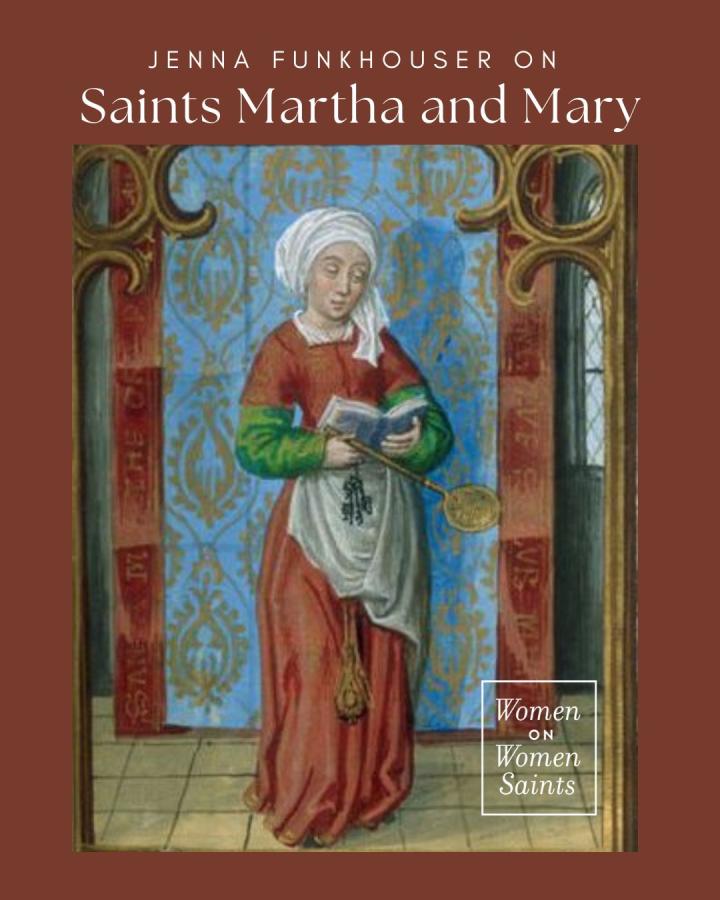
Some individuals from the scriptures become a “type” in themselves, a figure so recognizable that we begin to refer back to them with a shorthand of sorts. Sts. Martha and Mary are two such figures, inspiring countless books, articles, and sermons on the importance of prayer over activity. Who, after all, has not heard the injunction to, “Be a Mary, not a Martha?” And how many of us have not sometimes called this story to mind involuntarily when preparing for a large number of guests?
It was to my great surprise, then, that I recently uncovered a medieval Christian manuscript which contains a hagiography of Martha’s later life. First of all, I have to admit I was surprised to discover that I had never given either Mary or Martha’s story much of a second thought after the tumultuous events of Lazarus Saturday and Holy Week. I had not been properly curious about where such a dramatic event might have taken them. Second, I was extremely surprised to see that it was Martha, not Mary, whose story was retold (although admittedly, Mary does play a role within her sister’s story). Somehow Martha went from bearing the brunt of the moral of the story to becoming a powerful figure in her own right. And the more I read, the more impressed I was at how “the rest of the story” concludes the early parable on prayer and hospitality in astounding ways.
In this account, St. Martha is called the “hostess of our Lord Jesus Christ.” Claiming her to be of royal heritage and unmarried, it briefly mentions the account in the Gospels, reflecting that she asked Mary for help in serving Christ chiefly because “she thought that all the world was not sufficient to serve such a guest.” Even here, it is her sense of what is due to Christ that defines her, her lavish attention to hospitality out of honor and love.
The account goes on to tell us what we read in many Orthodox biographies of Mary, Martha, and Lazarus: that after Christ’s rising from the dead, they were baptised along with many other disciples. After the murder of St. Stephen, a persecution against the Jerusalem Church broke out. Along with many others, the three siblings were placed in a boat with no oars or provisions and set sail to presumably either exile or death. We know from our Orthodox tradition that they made it to Cyprus - however, this account states that they first miraculously landed at Marseille, becoming religious refugees who went on to proclaim the gospel to several communities, including Aix and Avignon.
Right away, as I read her hagiography, I felt I was encountering a completely different woman than the one often portrayed as stressed and complaining. Her first act on arriving somewhere near Avignon was to defeat a great beast with some holy water and the sign of the cross, then bind him in her girdle for the villagers to kill. She and Mary then allegedly lived in that place for some time in an ascetic period of fasting and prayer, eventually gathering “a great convent of sisters” known for (what else?) taking care of the hungry.
Although The Golden Legend’s hagiography was written around 1259 to 1266 and is therefore considered part of the Catholic tradition, these stories were likely present in the oral tradition from a much earlier time. Whether or not all of these events actually happened, what struck me was the way that in this account, St. Martha’s redemption was towards the direction of her naturally strong and noble nature. Rather than having this strength of purpose “flattened out,” it was used towards the continuation of the Kingdom. Together, these sisters had learned together how to both spend days in prayer and feed others, how to devote themselves entirely to Christ and fight evils that threatened those around them. I can imagine them smiling, arm in arm, as they led the daily rhythms of work and prayer, laughing about how once they seemed so opposite to each other. In foreign lands, they found ways to transcend their natural “otherness” as a stranger and continue their vocation of lavish hospitality and listening, creating a place known for its welcome and nourishment.
We know from other accounts that St. Martha and St. Mary continued on in their ministry with St. Lazarus, taking the Gospel to various lands before settling in Cyprus. By then, St. Martha had become known as a woman of maturity, strength, common sense, and concern for others. At the hour of her death, it was said that Christ spoke to her, welcoming her into his Kingdom. Once again, the roles of guest and host had reversed.
Quotes are from The Golden Legend, CAMBRIDGE UNIVERSITY PRESS, 1914 edition.
Jenna Funkhouser is a freelance writer and poet who has loved writing for Axia this past year. She lives in Portland, Oregon, where she studies ancient mosaics and printmaking and helps tend a garden full of surprises.



